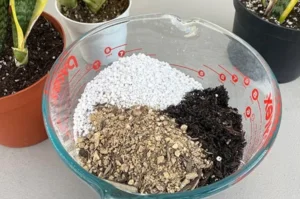Snake plants, also known as Sansevieria, are some of the toughest and easiest houseplants to grow. Their tall, upright leaves and low maintenance needs make them a favorite in homes and offices alike. However, despite their hardiness, one common mistake plant owners make is overfertilizing them.
Overfertilization might seem like a good way to encourage fast growth, but in reality, it often leads to more harm than good. This article will guide you through the reasons why overfertilizing your snake plant is dangerous, how to spot the warning signs, and what you can do to keep your plant healthy.
What Happens When You Overfertilize a Snake Plant?
Fertilizers contain nutrients like nitrogen, phosphorus, and potassium. These are essential for healthy growth, but too much of them can overwhelm your plant. Snake plants, in particular, grow slowly and require very little feeding. When given excessive fertilizer, they can experience a number of issues.
Let’s look at what happens when your snake plant gets too much fertilizer.
1. Salt Buildup in the Soil
Each time you fertilize, salts from the fertilizer are left behind in the soil. If you fertilize too often or in heavy amounts, these salts accumulate over time. This buildup makes it harder for the roots to absorb water, which stresses the plant. In some cases, it can dry out the roots completely, causing lasting damage.
2. Damaged Roots
When fertilizer is too strong, it can burn the roots. This is known as fertilizer burn. Instead of helping the plant grow, it weakens the roots and limits their ability to support the rest of the plant. Damaged roots are more prone to rot, especially if the plant is watered heavily or sits in damp soil.
3. Leaf Discoloration
One of the first signs of overfertilizing is the appearance of yellow or brown tips on the leaves. You may also notice crispy edges or fading color in the leaves. These symptoms are often confused with underwatering or sun damage, but overfertilization is a likely cause, especially if you’ve been feeding the plant regularly.
4. Stunted or Weak Growth
It might seem odd, but giving your plant too many nutrients can slow its growth. Overfed snake plants often grow unevenly or produce weak, floppy leaves that lack the plant’s usual strength. In some cases, growth may stop entirely.
5. Increased Risk of Pests
A snake plant stressed from overfertilization becomes more vulnerable to pests. Fungus gnats, mealybugs, and spider mites are more likely to appear in rich, overfed soil. These pests thrive in soft, stressed plant tissue and can quickly spread if not addressed.
Why Snake Plants Don’t Need Much Fertilizer
Snake plants are built to survive in poor, dry soils. In their natural environment, they grow in nutrient-poor, rocky ground and go long periods without water. This makes them very efficient in using what they get. Feeding them too often or too heavily goes against their natural needs.
For most indoor environments, feeding your snake plant once every 1–2 months during the growing season (spring and summer) is more than enough. In fall and winter, you can skip fertilizing altogether.
How to Recognize Overfertilization
Not sure if you’ve overdone it? Look out for these signs:
- Brown or yellow tips on the leaves
- Leaves that feel dry or brittle
- Slowed or abnormal growth
- White crust or residue on the surface of the soil
- Wilting despite regular watering
If you notice two or more of these symptoms and you’ve been feeding your plant often, it’s time to take action.
How to Fix an Overfertilized Snake Plant
1. Pause All Feeding
Stop adding fertilizer immediately. Give your plant time to recover on its own without additional nutrients.
2. Flush the Soil
Use clean, room-temperature water to thoroughly rinse the soil. Let the water run through the pot several times to wash out excess fertilizer salts. Be sure your pot has proper drainage so the water doesn’t sit at the bottom.
3. Repot If Needed
If the soil looks compacted or has a visible white crust, repot the plant into fresh soil. Choose a well-draining cactus or succulent mix, and inspect the roots as you go. Trim off any soft or mushy roots before repotting.
4. Trim Damaged Leaves
If the tips of your snake plant leaves are dead or heavily discolored, you can snip them off with clean scissors. This won’t hurt the plant, and it helps redirect energy to healthy growth.
5. Wait Before Fertilizing Again
Give your plant a break for at least 6–8 weeks. Watch for signs of new growth and improved leaf color before resuming a gentle feeding schedule.
Best Practices for Fertilizing Snake Plants
Here’s how to feed your snake plant the right way:
- Use diluted fertilizer. Always mix to half or quarter strength.
- Feed only in active growth periods. Fertilize during spring and summer only.
- Choose a balanced formula. A 10-10-10 or 20-20-20 blend works well, or use a fertilizer designed for succulents.
- Never fertilize a stressed plant. Avoid feeding if your plant is newly repotted, sunburned, overwatered, or recovering from damage.
Conclusion
Fertilizer can be a helpful tool in your plant care routine, but only when used carefully. Snake plants are naturally low-maintenance and don’t need heavy feeding to thrive. Too much fertilizer does more harm than good, leading to salt buildup, root damage, and weak growth.
The best approach is to feed lightly and sparingly while focusing on other essentials like proper light, watering, and soil. By avoiding the trap of overfertilizing, you’ll help your snake plant live a long, healthy life with vibrant green leaves and strong roots.






